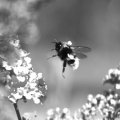The combination of music and mathematics can add up to listening enjoyment, according to composer and University of Queensland PhD student Kent Farbach.
Mr Farbach, whose PhD in composition is being supervised by Dr Philip Bracanin, used a mathematical formula known as the Fibbonaci Sequence to provide the structure for a piece called Tangerine.
The Fibbonaci Sequence starts by adding one and one and continues by adding the previous two numbers.
Mr Farbach used the Sequence for the rhythm and phrasing, as well as the motif for viola at the beginning of the piece.
The world premiere performance of Tangerine by the University's resident ensemble Perihelion was a highlight of last month's XIIth International Congress of Mathematical Physics held at the St Lucia campus.
The piece, specially commissioned for the Congress, was greeted by an enthusiastic expert audience as further proof of the connection between music, mathematics and physics.
Musical concerts are rarely part of the program at scientific conferences, particularly where one of the main pieces is sponsored through Australia Council for the Arts funding.
Although he has 'steered clear of systems' in favour of a more intuitive approach in the past, Mr Farbach was eager to follow great composers such as Bela Bartok in drawing inspiration from the Sequence.
'It is also used a lot by painters because the results are very pleasing to the eye,' Mr Farbach said.
'When it is used in music composition the climaxes tend to be five-eighths of the way through the piece rather than at the end.'
'Music for Strings and Percussion, written by Hungarian composer Bela Bartok at the beginning of the century, uses the Fiobbonaci Sequence and is often part of the soundtrack for action films.'
Mr Farbach has established an international reputation since his orchestral work Life Stratum won the prestigious Amadeus Prize in Dublin 1991, celebrating Mozart's bicentenary.
The Queensland Conservatorium of Music graduate, who obtained a master of music degree at Griffith University in 1995, has had works performed by symphony and philharmonic orchestras around Australia, New Zealand and in Ireland.
His current projects include a 90-minute score for the main performance at the Queensland Film Festival, and commissions for both the University of Queensland and the Sydney Philharmonic Choir.
He also gives regular tutorials on 20th Century music at the University.
For more information contact Mr Farbach (telephone 07 3379 8281)



